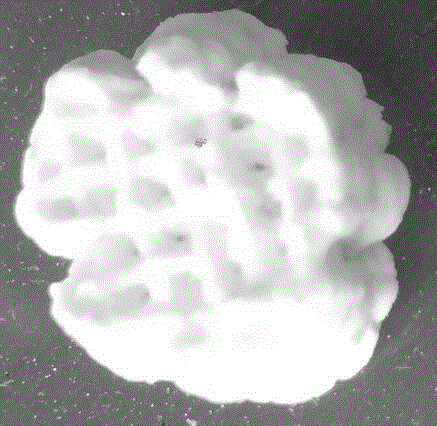Preparation method for three-dimensionally printing biological ceramic scaffold by using a biological ceramic ink
A technology of bioceramics and three-dimensional printing, applied in tissue regeneration, medical science, prosthesis, etc., can solve the problems of immune rejection and disease transmission in allogeneic transplantation, and achieve the avoidance of scaffold structure distortion, high biocompatibility, Energy Saving Effect
- Summary
- Abstract
- Description
- Claims
- Application Information
AI Technical Summary
Problems solved by technology
Method used
Image
Examples
Embodiment 1
[0032] Embodiment 1, the preparation of hydroxyapatite mud, are as follows:
[0033] Take an appropriate amount of egg shells, wash them with tap water and dry them, use 2% acetic acid to clear the egg shells, and dry them in an oven at 60°C;
[0034] In a ball mill, use zirconia as a grinding medium to grind eggshells for 2 hours at high speed. 100 μm filter to filter powder;
[0035] Weigh 10 grams of egg shells, add 50 grams of 85% orthophosphoric acid, and leave overnight at room temperature to prepare hydroxyapatite slurry.
example 2
[0036] Example 2, the preparation of bioceramic ink, are as follows:
[0037] The silk fibroin solution prepared by degumming silk for 10 minutes, 30 minutes and 1 hour was placed in a refrigerator at 4°C for 24 hours, dried with cold air at 10°C for 48 hours, and ventilated and dried at room temperature for 24 hours to obtain 15%~30% (wt / wt) silk prime solution;
[0038] Add the hydroxyapatite slurry prepared above to the silk fibroin solution to obtain bioceramic ink, the ratio is 1:1~1:9;
[0039] Example 3, three-dimensional controllable microstructure bioceramic scaffold preparation, refer to figure 1 , figure 2 ,details as follows:
[0040] Place the bioceramic ink in the syringe, select a needle with a wedge-shaped inner cavity, 20G, to obtain the bioceramic ink;
[0041] Load the print model (.STL) designed by SolidWorks into Repetier software, and use the Silcs plug-in to layer the model;
[0042] Bioceramic inks form three-dimensional ceramic scaffolds with dif...
PUM
 Login to View More
Login to View More Abstract
Description
Claims
Application Information
 Login to View More
Login to View More - R&D
- Intellectual Property
- Life Sciences
- Materials
- Tech Scout
- Unparalleled Data Quality
- Higher Quality Content
- 60% Fewer Hallucinations
Browse by: Latest US Patents, China's latest patents, Technical Efficacy Thesaurus, Application Domain, Technology Topic, Popular Technical Reports.
© 2025 PatSnap. All rights reserved.Legal|Privacy policy|Modern Slavery Act Transparency Statement|Sitemap|About US| Contact US: help@patsnap.com


